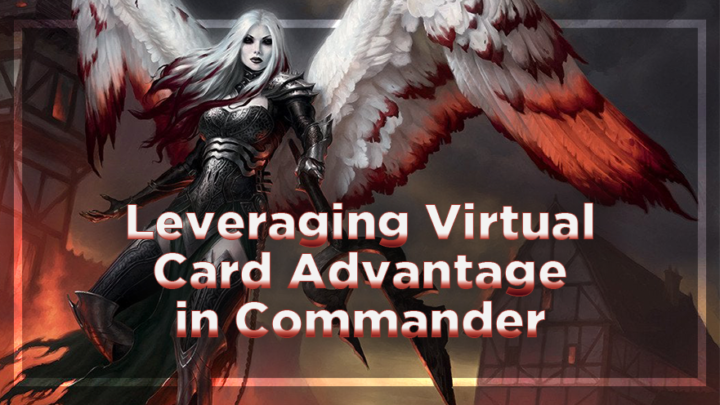I’d like to talk about something a little different today, and that’s the idea of virtual card advantage.

I recently put together a draft list of a Boros flicker deck, helmed by Archangel Avacyn. My goal was to have a little fun, running lots of cool ETB creatures like Dualcaster Mage and Wildfire Devils. Instead of the usual “greatest hits” of Boros, I’d be focusing on a more defensive game, wringing out card advantage on board until the end game.
In one of the deck’s first outings, I managed to clean up by flying under the radar for much of the game. The one thing that stood out about the game, though, was that I never cast my commander. Not once!
Exactly how that strategy managed to win me the game is something we will look at today: virtual card advantage. I’ll also be dropping a link to my decklist.
Before we get started, though, I’ll quickly go over the concept of card advantage for those unfamiliar. I’m far from a pro when it comes to playing competitively, so forgive me if I miss a little nuance here, but let’s get down to it.
Card Advantage
Card advantage is at the very heart of Magic gameplay. It’s the idea that you spend your cards more efficiently than an opponent, and in doing so, you gain an advantage. It’s the idea that, whenever you make a play, you’re getting ahead. Whether that’s turning one draw spell into multiple cards, or using one copy of Mind Rot to force an opponent to discard two cards, the idea is that you’re up on cards over the opponent.
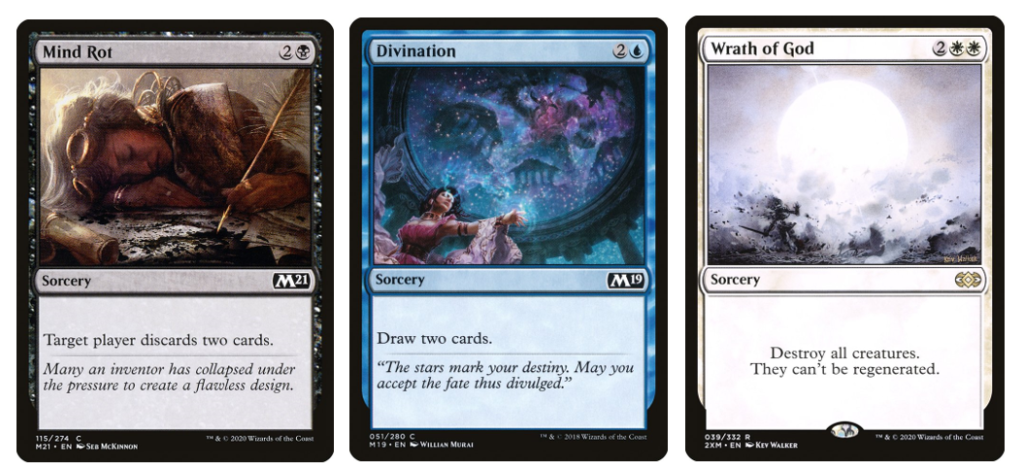
Another application for this concept is when you use a board wipe to dispatch multiple creatures. You’ve spent one card to destroy your opponent’s many. The term “2-for-1” is almost as pervasive as the term “card advantage,” and it captures the idea perfectly.
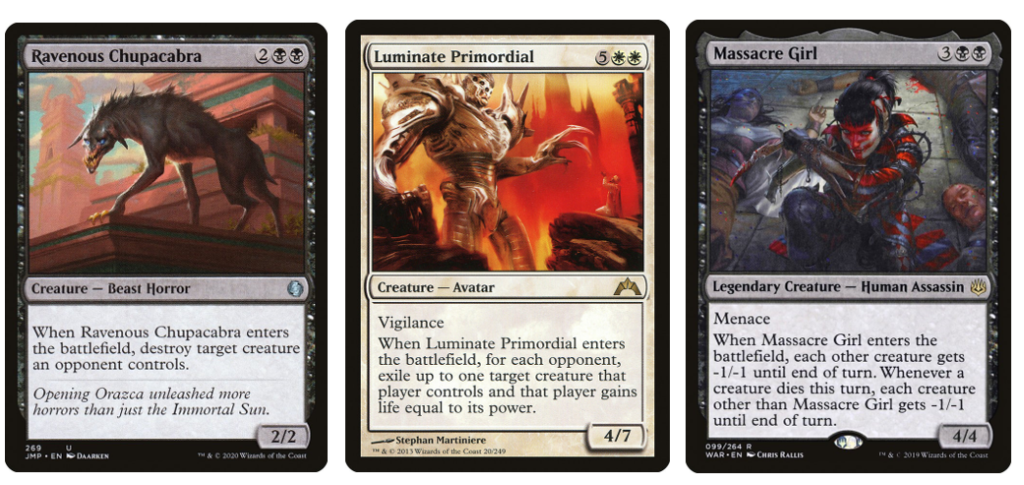
If we consider the three cards above, they escalate from a 2-for-1 — removing a creature and gaining a creature, in Ravenous Chupacabra — through a 4-for-1, through to limitless potential in Massacre Girl, a card which can wipe countless creatures when set up right.
You may not realize it, but your deck-building choices in Commander largely come down to how much value you can squeeze out of each card. Whether you’re using modal spells in order to squeeze more than 100 spells into your deck, or using Quadrant Theory to evaluate how cards perform in different situations, it all comes back to how much advantage you can get out of your cards.
Virtual Card Advantage
Virtual card advantage, or VCA for short, is much more of a nebulous term, and not everyone agrees on the exact definition. The easiest way to describe it, for me, is the idea that you managed to achieve an advantage by forcing an opponent to react to your game plan in a way that loses them card advantage or tempo.
This older Wizards article has a good example in lining up an Izzet Staticaster versus a handful of Elvish Mystics, but when it comes to Commander, the most common example you’ll run into is one creature (or permanent) holding back an entire army.

Let’s assume for a moment that an opponent has Odric, Master Tactician in play, which will help them orchestrate devastating combat steps. If we have a Soul Snare in play, however, we’re pretty safe.
Why? Well, because unless that Odric can leverage a lethal (or notable) attack, the opponent will be throwing it away in order to poke through just a little bit of damage. They’ll also be leaving themselves wide open for attacks on the backswing. Because this is a bad play, we can effectively hold off big swings for multiple turns with the threat of our Soul Snare activation.
This is VCA: we’re not spending a card, but the very threat of an effect helps us gain advantage.

VCA skills can be refined more readily in 1v1 Magic, and in Limited in particular. One of the biggest mistakes rookie Limited players make is fearing counterspells. Back in Amonkhet draft, getting your Glorybringer countered in Game 1 might make a less-seasoned player balk at the thought of trying to play their bomb creature in subsequent games.
The mind games employed by the blue player here can produce VCA: by not playing aggressively enough, the player with the Glorybringer might lose tempo and take too long to close the game. Holding up open mana is the oldest trick in the book, and a bluff we all know how to make. It’s also a way to gain an advantage without spending cards.
Virtual Card Advantage in Commander
Gaining VCA in Commander is a little trickier. Your cards are worth ¼ of what they usually are, as for every card you draw in your draw step, your opponents draw a collective three. It’s also tough to gain VCA in meaningful amounts. Holding up mana or on-board effects each turn cycle loses you way more tempo than in 1v1 Magic; you’ll be falling further behind — and faster — when three other players are attacking and playing spells.
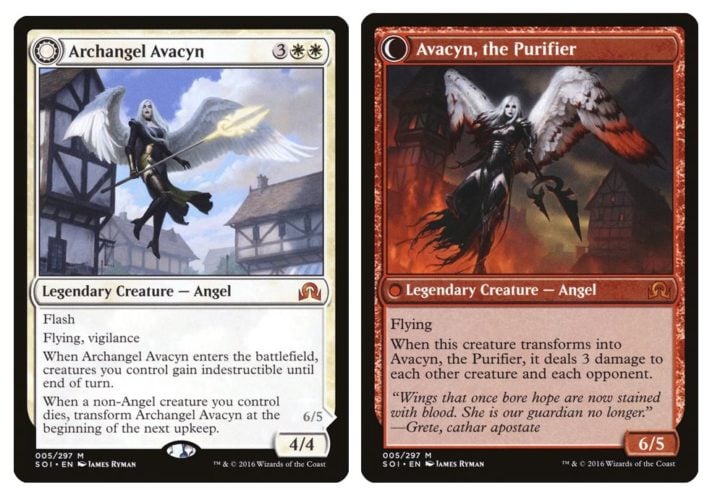
At this point, I’ll circle back to Avacyn, as I believe she’s the perfect example of how to generate VCA in EDH. The threat of the Avacyn player having access to five or more open mana is enough to generate multiple possibilities for any player wanting to interact with or attack them.
Avacyn, first and foremost, is a great flash blocker that can block flying threats. She can also grant the rest of the team indestructible, giving you a “free” block. These first two modes can essentially act as a fog at the floor, and be as powerful as a one-sided wrath when blockers are deployed correctly. It’s also a way to negate Commander or Voltron damage.
But the possibilities don’t end there. If the Avacyn player has an on-board way to lose a non-Angel creature, then Avacyn can turn into a board wipe of sorts during the next upkeep. This is often enough to clear out many utility creatures, and is a ticking time bomb best left off the table, in the Command Zone.
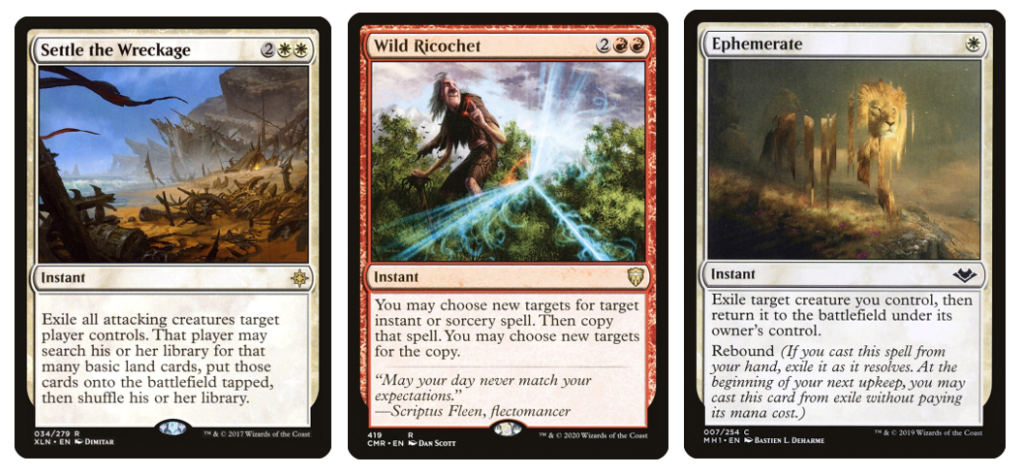
Of course, the possibilities that abound from five or more open mana. Boros has access to a lot of tricky spells, and even if that mana has mostly been spent on Avacyn, there’s more cheap interaction that can mess things up, including new format stalwart Deflecting Swat, which can come down for free.
If you combine Avacyn with other on-board game pieces, like Ghostly Prison, Soul Snare, Chaos Wand, or Maze of Ith? Well, the list of things that can go wrong starts to pile up, and it’s not really worth finding out how you’d misstep when there’s another player trying to go off across the table.
This is exactly how the game played out the other week. I was able to use on-board effects — Avacyn ready to be cast, a sacrifice-ready creature in play, and the threat of activation of my on-board Chaos Wand — to ensure no attacks against me were profitable.
By generating VCA with Avacyn, I could make my cards go further, and by not overly committing to the board, I was able to fly under the radar. It works — at least until your opponents figure it out and gang up on you. 😉
Mind Games
Avacyn isn’t the only example of VCA in Commander, though — there are many.

Enchantment-based “rattlesnake” effects are also a way to gain VCA, and you can even recur them in decks with Muldrotha, the Gravetide and Sevinne’s Reclamation to generate even more advantage. Sometimes just the threat of one of these cards lingering over the table is enough to slow people down and stop them playing what they actually would like to be playing.
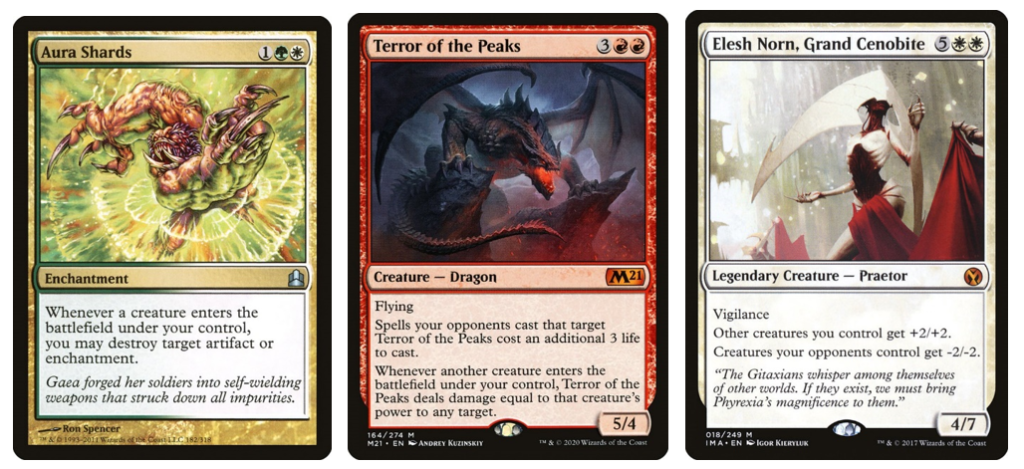
Aura Shards is another effect that can gain you card advantage. Cards like this — including Terror of the Peaks and Elesh Norn — can have a stifling effect on an opponent’s ability to play the game. They’ll be reluctant to play out their enchantments and creatures, as they’re virtually dead on board with these effects in play a lot of the time.
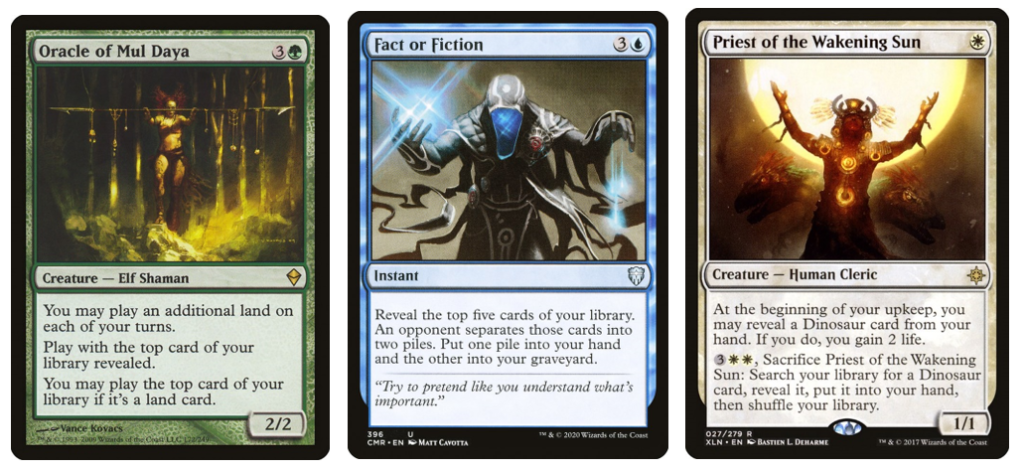
Cards that reveal cards to the opponent are also great for gaining VCA. Whether through revealing what you draw, or what’s on top of your library, you can use that information to your own ends, rather than have it be a detriment. If people can see what’s coming, you can lead them down a path to ruin by thinking one step ahead. Revealing Zacama with Priest of the Wakening Sun might seems like a bold move, but when you’re trying to bait out removal because you have a redirect in hand? That’s 4D chess right there!

Another card I’ve been very fond of lately is Stalking Leonin. The mind games you can achieve with this card are worth the investment, and the three mana spent to cast it will often net you significantly more advantage than merely exiling an attacking creature. This goes doubly if you have ways to recur or flicker it in order to reset the card.
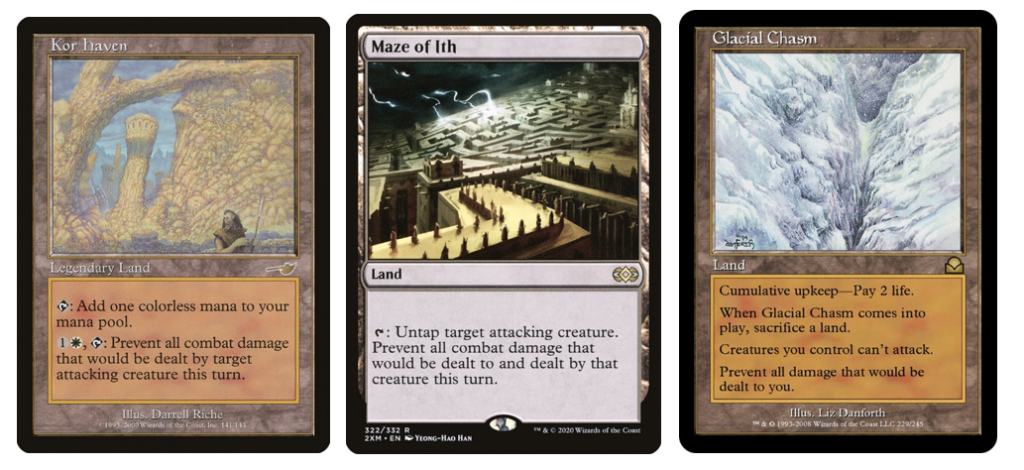
You also have many good lands available that can generate VCA. With a Maze of Ith or Spires of Orazca (the other side of Thaumatic Compass), you can ensure your opponents won’t attack you with more than one creature a turn. Kor Haven and Glacial Chasm are other ways to do this, and while they are strong cards, I would caution against overly committing to a pillowfort. It’s tempting to load up on these powerful effects, but putting too many into a deck can be detrimental, too.
Firstly, building a pillowfort will grind the game to a halt. In some playgroups, this can lead to an unfun experience for the other players. Secondly, it will eventually lead the rest of the table to decide to eliminate you, and if they see through your ruse quickly enough, you’ll be ejected before you can set up.
Balancing Fun with VCA
So, if being overly defensive has the potential to make games unfun, how best can you leverage VCA in Commander?
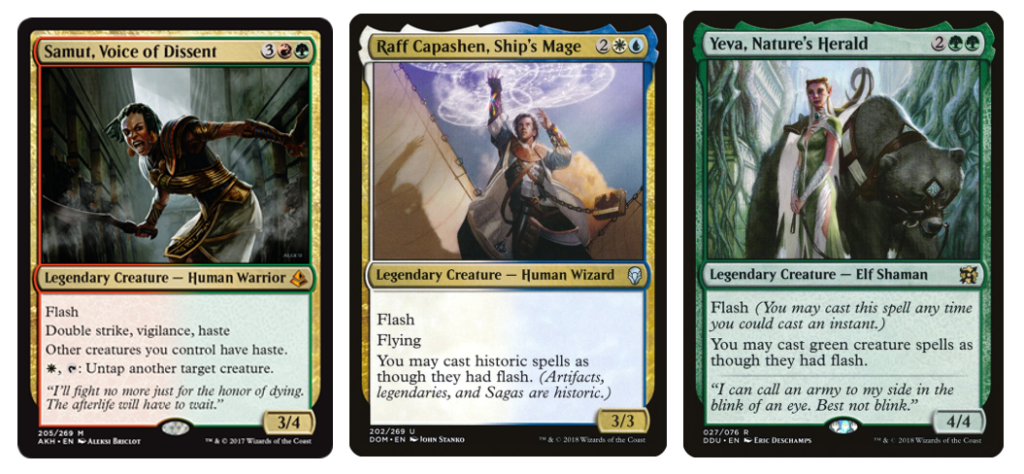
Well, aside from the ways we’ve discussed — in moderation, of course — try to consider playing more creatures with flash, for instance. Being able to play at instant speed offers a lot of VCA because you can cast your spells whenever it’s convenient, and you can make people think twice before trying to interact with you.

If you want to try the new Nevinyrral, maybe focus on a zombie tribal deck with a way to make a bunch of tokens in the command zone, rather than a strict Stax-style lockdown. You can use the threat of the wipe to achieve your advantage, without building the deck in such a way to really lean into it.
I’d also argue that haste is still one of the most underrated abilities in Commander. While it’s not strictly a form of VCA, it does play on a similar axis — preying on opponent’s shortcomings to achieve something they’re unprepared for.

When choosing spells and effects, try and go for ones with the opportunity to be political, like Duelist’s Heritage. It can make combat pretty complicated for each of your opponents, and on the plus side, it can also help you to push damage through. Vortex Elemental is a one-time effect, and one that’s cheap and easy to pull off. Tangle, meanwhile, allows you to fog while also advancing the game; instead of merely preventing the damage, you can keep the opponent’s shield down for a full turn cycle to bring things toward a conclusion.
Boros Blink Deck
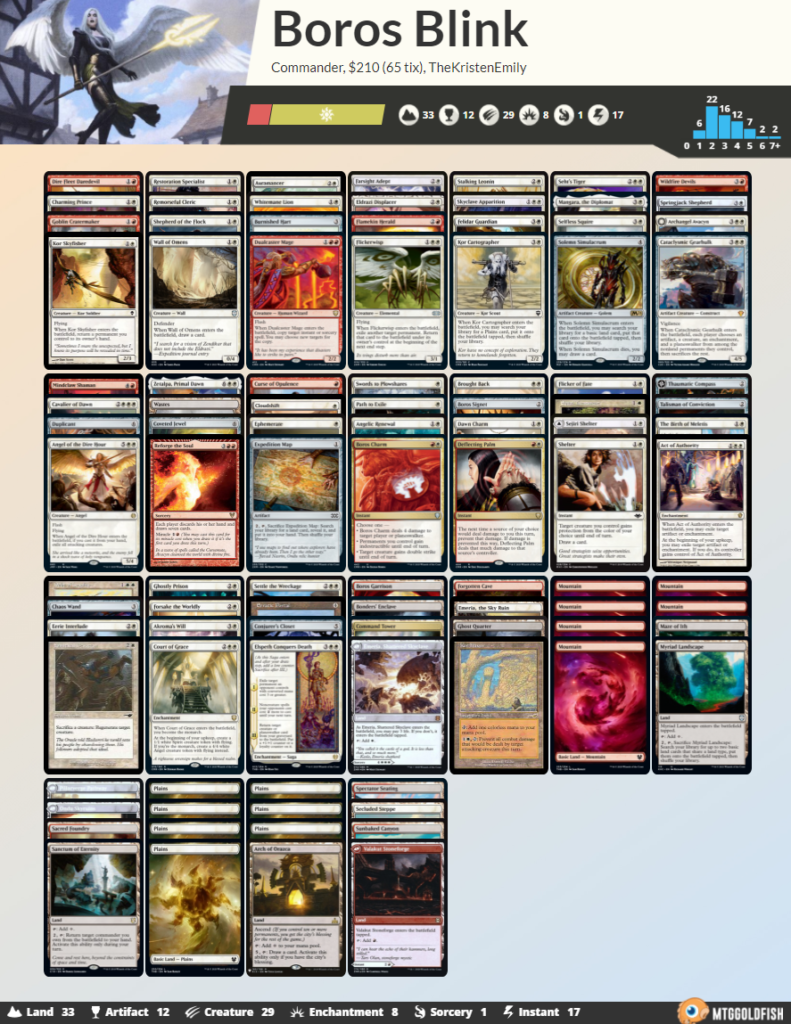
My Boros Blink deck is one I’m pretty happy with after a first pass. It could potentially use some of the new Kaldheim cards like Glorious Protector, Doomskar and Cosmic Intervention, but I’m liking how it’s shaping up. If you’d like to play around with a more reactive deck, then you might be able to get some ideas from this one.
Cards like Deflecting Swat and Selfless Spirit certainly wouldn’t go amiss, either, and neither would something like Sun Titan. The other goal of the deck was to play some lesser-played cards and not fuss overtly about having access to best in slot cards.
The goal here is to let the game proceed as normal, but to navigate the game in such a way as to both not lean into being the clear threat, but also to survive down to the last two. Rather than building a threatening, Stax-heavy pillowfort, or beating people into submission with a lot of board wipes, you’ll gain gradual points of advantage with on-board effects, before throwing everything you have into turning the corner.
Let me know on Twitter what your favorite ways to generate virtual card advantage are. I hope you found this primer on the topic useful!

Kristen is Card Kingdom’s Head Writer and a member of the Commander Format Panel. Formerly a competitive Pokémon TCG grinder, she has been playing Magic since Shadows Over Innistrad, which in her opinion, was a great set to start with. When she’s not taking names with Equipment and Aggro strategies in Commander, she loves to play any form of Limited.

